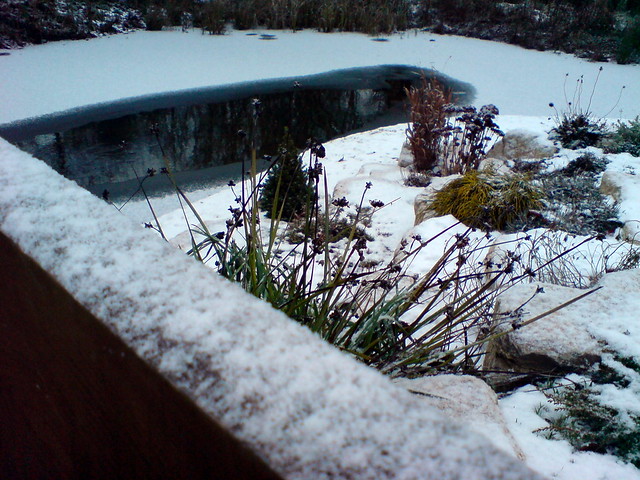Fishes can be wintered either outdoors or indoors. This will depend on the construction of the entire pond according to the inclination of the owner. This article will focus about things that a hobbyist can do to properly protect and care for his fishes during winter if his pond is situated outdoors.
If you’re living in a country where winter is the most prominent season of the year, better build a pond wherein a portion of it is about 30-45 inches deep.
 |
| Fish pond in winter (Photo credit: Wikipedia) |
This will protect the fishes from long periods of cold spells. Even more drastic than cold water is the building up of gasses which are toxic in a pond that is iced over completely for a certain amount of time.
Therefore, it is mandatory that a part of the pond’s surface is kept open to enable the pond to circulate air that results to the disposal of deadly gasses and adds oxygen. You can accomplish this by:
a. Aerator.
This is a large air stone that is operated by an aquarium air pump which can constantly create a small opening inside the ice. Unfortunately, placement is quite critical and hard to be arranged precisely.
Ideally, the aerator should be placed halfway measuring from the deepest part of the entire pond and should be monitored frequently. Chances are, if the aerator is placed too near from the surface, it has a tendency to freeze, if placed deeper, it can chill the entire pond.
b. De-Icer or Heater.
There are different kinds of de-icers that can be safely used for performed ponds, liner or even in concrete. Out of the use of electricity, a puncture can be made through the iced pond where it serves as breathing hole for fishes.
There are different kinds of de-icers that can be safely used for performed ponds, liner or even in concrete. Out of the use of electricity, a puncture can be made through the iced pond where it serves as breathing hole for fishes.
Sometimes, the most efficient de-icers or heaters can produce an ice-free pond even if the winter weather is overwhelming.
c. Water pump.
Same limitations to an aerator, a water pump can provide an opening on the surface of the pond but with several conditions. One condition is that the pump must be mounted on the deepest part yet should be far enough from the bottom to avoid water circulation and far enough from the surface so that it wouldn’t solidly freeze. Regularly inspect the pump because it can freeze solid or run dry, these can destroy the integrity of the pump.
Covering the pond can be helpful for the fishes and the devices used. It can protect the pond from extreme coldness and will reduce the amount of electricity that your heater needs. Although, the cover must always be raised to enable gas exchange and prevent toxic substances to reside in the pond. The structure would turn out like a wooden frame is built over the pond at its surface then it will be covered with plywood. Insulating materials can follow. The covering must possess sturdiness to withstand the long days of snow accumulation.
Last concern is feeding your fish. Actually, you can drop this idea for even if your pets seem to be quite interested, they will just ignore the food that you’ll give. This is because during cold days, metabolism can be quite sluggish. Although, to prevent starvation, you can supplement them food that can easily be digested like the ones that are made from wheat germ.
Proper care of your pond fishes during winter can be crucial to your pets especially when it is located
outdoors.



